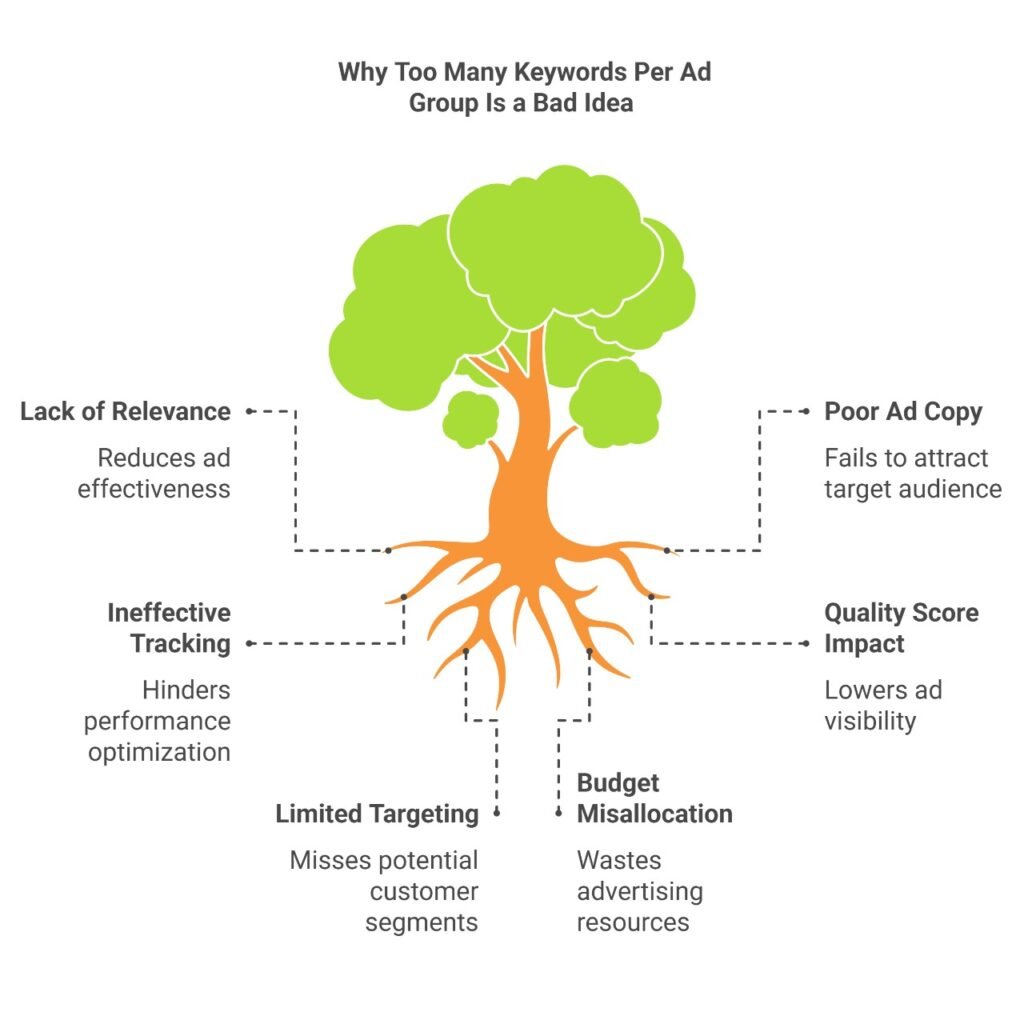Why Too Many Keywords Per Ad Group Is A Bad Idea
When managing a paid search campaign, one of the most important things to pay attention to is the structure of your ad groups. It can be tempting to try to stuff as many keywords as possible into one ad group in order to save time or reach more people, but this approach often results in poor performance. In this blog, we’ll examine why having too many keywords in one ad group is not good for PPC campaigns and why targeting more specific and organized ad groups are a better bet.

Lack of Relevance
One of the most important reasons why having too many keywords in an ad group is bad is the loss of ad relevance. Google and other search engines will prioritize ad relevance when they determine which ads to display and how much you will pay per click.
When you throw a bunch of different keywords into one ad group, your ad copy will likely be a poor match for many of those terms. For example, if your ad group contains both “buy running shoes” and “running shoe reviews,” the searcher looking for reviews is less likely to find your ad relevant, as it’s geared toward direct purchases. This misalignment reduces the overall quality score of your ad, leading to higher CPC (cost-per-click) and less efficient ad spend.
Failure to Write Targeted Ad Copy
The ad copy is the key to making users click on your ad, and one of the best ways to write compelling, relevant ads is to match the ad copy closely with the keywords in the ad group. When you cram too many keywords into one group, it’s hard to create ad copy that works for all of them. The message is watered down, and you’re likely not meeting the search intent of your audience.
For instance, an ad copy of a whole ad group like “cheap running shoes” and “best running shoes for marathons” may not click to either the user looking for low-budget options or to the marathon user looking for marathon-specific specialist shoes.
Expectation and Needs Between the Cheap Runner and the Marathon User Are Pretty Diverse
Failure in Effective Tracking and Optimization of Performance
The main reason for running a PPC campaign is to track specific keywords in terms of how they are doing. When there are just too many keywords, it will prove difficult to tell which ones result in outcomes and which do not.
You would find it difficult to make data-driven decisions if your ad group has both highly converting terms and underperforming terms. You could end up wasting money on low-performing keywords while not optimizing the ones that could bring you higher returns.
Moreover, negative keywords, bidding adjustments, or pausing underperforming keywords become much more challenging when you have a large number of terms in a single ad group.
Quality Score Impact
The quality score of Google is a significant determinant of the cost of your ads. It mainly depends on how relevant your keywords, ads, and landing pages are. The grouping of loosely related or unrelated keywords will negatively affect your quality score.
Quality score depends on CTR expected and the relevance to ad plus experience in the landing page. So when your ad group is so big on keyword counts, a poor experience and irrelevant ad won’t allow a customer to understand which ads could give you, lowering the chances, so there’ll be high costs and reduced advertisement.
Lack of opportunity to target or segmentation
Since these small, keyword groups are being arranged in order, you’ll then be able to segment the ad groups so you can speak with a smaller number of audience subsets using messaging and targeting unique to each one, grouping keywords for similar meanings into one.
For example, you could have separate ad groups for “women’s running shoes,” “men’s running shoes,” “trail running shoes,” and “marathon running shoes.” Such segmentation will ensure your ads are relevant, and the messaging is more personal and effective. It’s an efficient way to increase conversion rates by aligning each ad group with a distinct search intent.
Poor Budget Allocation
Budgeting will not work well if you have a list of both high-volume and low-volume keywords. All your budget goes to high-volume keywords, so there is nothing much for the low-volume ones that can still generate valuable traffic. This creates an imbalance in which some keywords are not getting enough exposure while others are overexposed.
Complicated Reporting
As your account grows, having many keywords in one ad group can make reporting and analysis unnecessarily complex. Many keywords with diverging performance levels make it difficult to analyze what is working and not.
Structuring the ad groups with more focus makes it easier to spot trends, identify high-performing keywords, and optimize your campaigns.
Best Practices for Organizing Ad Groups
To avoid overloading your ad groups, you have the following best practices:
Group similar keywords together, and you aim to build an ad group as tightly themed with highly relevant keywords. You write specific ad copy and increase quality score.
Make use of the small number of keywords, at least around 10-15 related terms per ad group. It ensures that your campaign is always well-focused and pertinent.
Implement Keyword Match Types: Combine broad match, phrase match, and exact match keywords for more refined targeting without overloading the ad group.
Test and Optimize: Keep track of the performance and optimize the keywords for each ad group. That way, you could pause those poor performers and move the budget over to the top converting terms.
Conclusion
PPC world, structure is everything. Though it might look easy to fill up an ad group with all possible keywords, doing so may not only lower your relevance but also impact the quality score of your ads, as well as overall campaign performance. Focus on smaller, more tightly themed ad groups; improve your ads, spend your budget to the maximum, and then enjoy the best outcome in the long run.
Remember, the more targeted and organized your campaigns are, the more likely you are to achieve a high ROI. It’s worth investing the time in creating well-structured ad groups, even if it requires a little more effort upfront. Your performance will thank you for it.
